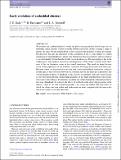Files in this item
Early evolution of embedded clusters
Item metadata
| dc.contributor.author | Dale, J.E. | |
| dc.contributor.author | Ercolano, B. | |
| dc.contributor.author | Bonnell, I.A. | |
| dc.date.accessioned | 2015-08-13T09:40:06Z | |
| dc.date.available | 2015-08-13T09:40:06Z | |
| dc.date.issued | 2015-07-21 | |
| dc.identifier | 209399644 | |
| dc.identifier | b6699339-0e86-44f6-b184-3c48518ccfc6 | |
| dc.identifier | 84938258813 | |
| dc.identifier | 000360827800074 | |
| dc.identifier.citation | Dale , J E , Ercolano , B & Bonnell , I A 2015 , ' Early evolution of embedded clusters ' , Monthly Notices of the Royal Astronomical Society , vol. 451 , no. 1 , pp. 987-1003 . https://doi.org/10.1093/mnras/stv913 | en |
| dc.identifier.issn | 0035-8711 | |
| dc.identifier.uri | https://hdl.handle.net/10023/7206 | |
| dc.description | This research was supported by the DFG cluster of excellence ‘Origin and Structure of the Universe’ (JED, BE). | en |
| dc.description.abstract | We examine the combined effects of winds and photoionizing radiation from O-type stars on embedded stellar clusters formed in model turbulent molecular clouds covering a range of masses and radii. We find that feedback is able to increase the quantities of dense gas present, but decreases the rate and efficiency of the conversion of gas to stars relative to control simulations in which feedback is absent. Star formation in these calculations often proceeds at a rate substantially slower than the freefall rate in the dense gas. This decoupling is due to the weakening of, and expulsion of gas from, the deepest parts of the clouds' potential wells where most of the star formation occurs in the control simulations. This results in large fractions of the stellar populations in the feedback simulation becoming dissociated from dense gas. However, where star formation does occur in both control and feedback simulations, it does so in dense gas, so the correlation between star formation activity and dense gas is preserved. The overall dynamical effects of feedback on the clusters are minimal, with only small fraction of stars becoming unbound, despite large quantities of gas being expelled from some clouds. This owes to the settling of the stars into virialized and stellar-dominated configurations before the onset of feedback. By contrast, the effects of feedback on the observable properties of the clusters - their U-, B- and V-band magnitudes - are strong and sudden. The time-scales on which the clusters become visible and unobscured are short compared with the time-scales which the clouds are actually destroyed. | |
| dc.format.extent | 17 | |
| dc.format.extent | 2886440 | |
| dc.language.iso | eng | |
| dc.relation.ispartof | Monthly Notices of the Royal Astronomical Society | en |
| dc.subject | Stars: formation | en |
| dc.subject | ISM: bubbles | en |
| dc.subject | H ii regions | en |
| dc.subject | QB Astronomy | en |
| dc.subject | QC Physics | en |
| dc.subject | NDAS | en |
| dc.subject.lcc | QB | en |
| dc.subject.lcc | QC | en |
| dc.title | Early evolution of embedded clusters | en |
| dc.type | Journal article | en |
| dc.contributor.sponsor | Science & Technology Facilities Council | en |
| dc.contributor.institution | University of St Andrews. School of Physics and Astronomy | en |
| dc.identifier.doi | 10.1093/mnras/stv913 | |
| dc.description.status | Peer reviewed | en |
| dc.identifier.grantnumber | ST/J001651/1 | en |
This item appears in the following Collection(s)
Items in the St Andrews Research Repository are protected by copyright, with all rights reserved, unless otherwise indicated.

